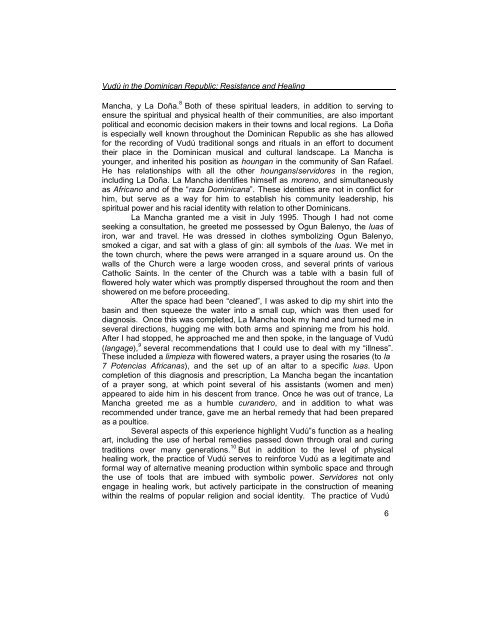Vudu in the Dominican Republic
by Ana-Maurine Lara
by Ana-Maurine Lara
Create successful ePaper yourself
Turn your PDF publications into a flip-book with our unique Google optimized e-Paper software.
Vudú <strong>in</strong> <strong>the</strong> Dom<strong>in</strong>ican <strong>Republic</strong>: Resistance and Heal<strong>in</strong>g<br />
Mancha, y La Doña. 8 Both of <strong>the</strong>se spiritual leaders, <strong>in</strong> addition to serv<strong>in</strong>g to<br />
ensure <strong>the</strong> spiritual and physical health of <strong>the</strong>ir communities, are also important<br />
political and economic decision makers <strong>in</strong> <strong>the</strong>ir towns and local regions. La Doña<br />
is especially well known throughout <strong>the</strong> Dom<strong>in</strong>ican <strong>Republic</strong> as she has allowed<br />
for <strong>the</strong> record<strong>in</strong>g of Vudú traditional songs and rituals <strong>in</strong> an effort to document<br />
<strong>the</strong>ir place <strong>in</strong> <strong>the</strong> Dom<strong>in</strong>ican musical and cultural landscape. La Mancha is<br />
younger, and <strong>in</strong>herited his position as houngan <strong>in</strong> <strong>the</strong> community of San Rafael.<br />
He has relationships with all <strong>the</strong> o<strong>the</strong>r houngans/servidores <strong>in</strong> <strong>the</strong> region,<br />
<strong>in</strong>clud<strong>in</strong>g La Doña. La Mancha identifies himself as moreno, and simultaneously<br />
as Africano and of <strong>the</strong> “raza Dom<strong>in</strong>icana”. These identities are not <strong>in</strong> conflict for<br />
him, but serve as a way for him to establish his community leadership, his<br />
spiritual power and his racial identity with relation to o<strong>the</strong>r Dom<strong>in</strong>icans.<br />
La Mancha granted me a visit <strong>in</strong> July 1995. Though I had not come<br />
seek<strong>in</strong>g a consultation, he greeted me possessed by Ogun Balenyo, <strong>the</strong> luas of<br />
iron, war and travel. He was dressed <strong>in</strong> clo<strong>the</strong>s symboliz<strong>in</strong>g Ogun Balenyo,<br />
smoked a cigar, and sat with a glass of g<strong>in</strong>: all symbols of <strong>the</strong> luas. We met <strong>in</strong><br />
<strong>the</strong> town church, where <strong>the</strong> pews were arranged <strong>in</strong> a square around us. On <strong>the</strong><br />
walls of <strong>the</strong> Church were a large wooden cross, and several pr<strong>in</strong>ts of various<br />
Catholic Sa<strong>in</strong>ts. In <strong>the</strong> center of <strong>the</strong> Church was a table with a bas<strong>in</strong> full of<br />
flowered holy water which was promptly dispersed throughout <strong>the</strong> room and <strong>the</strong>n<br />
showered on me before proceed<strong>in</strong>g.<br />
After <strong>the</strong> space had been “cleaned”, I was asked to dip my shirt <strong>in</strong>to <strong>the</strong><br />
bas<strong>in</strong> and <strong>the</strong>n squeeze <strong>the</strong> water <strong>in</strong>to a small cup, which was <strong>the</strong>n used for<br />
diagnosis. Once this was completed, La Mancha took my hand and turned me <strong>in</strong><br />
several directions, hugg<strong>in</strong>g me with both arms and sp<strong>in</strong>n<strong>in</strong>g me from his hold.<br />
After I had stopped, he approached me and <strong>the</strong>n spoke, <strong>in</strong> <strong>the</strong> language of Vudú<br />
(langage), 9 several recommendations that I could use to deal with my “illness”.<br />
These <strong>in</strong>cluded a limpieza with flowered waters, a prayer us<strong>in</strong>g <strong>the</strong> rosaries (to la<br />
7 Potencias Africanas), and <strong>the</strong> set up of an altar to a specific luas. Upon<br />
completion of this diagnosis and prescription, La Mancha began <strong>the</strong> <strong>in</strong>cantation<br />
of a prayer song, at which po<strong>in</strong>t several of his assistants (women and men)<br />
appeared to aide him <strong>in</strong> his descent from trance. Once he was out of trance, La<br />
Mancha greeted me as a humble curandero, and <strong>in</strong> addition to what was<br />
recommended under trance, gave me an herbal remedy that had been prepared<br />
as a poultice.<br />
Several aspects of this experience highlight Vudú‟s function as a heal<strong>in</strong>g<br />
art, <strong>in</strong>clud<strong>in</strong>g <strong>the</strong> use of herbal remedies passed down through oral and cur<strong>in</strong>g<br />
traditions over many generations. 10 But <strong>in</strong> addition to <strong>the</strong> level of physical<br />
heal<strong>in</strong>g work, <strong>the</strong> practice of Vudú serves to re<strong>in</strong>force Vudú as a legitimate and<br />
formal way of alternative mean<strong>in</strong>g production with<strong>in</strong> symbolic space and through<br />
<strong>the</strong> use of tools that are imbued with symbolic power. Servidores not only<br />
engage <strong>in</strong> heal<strong>in</strong>g work, but actively participate <strong>in</strong> <strong>the</strong> construction of mean<strong>in</strong>g<br />
with<strong>in</strong> <strong>the</strong> realms of popular religion and social identity. The practice of Vudú<br />
6

















